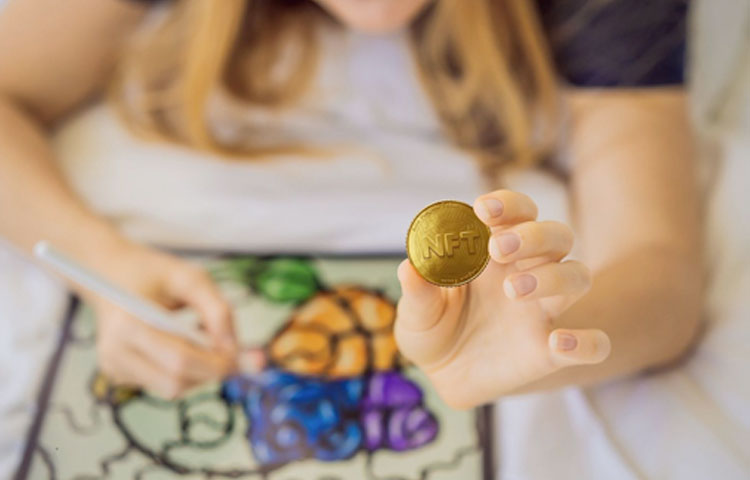

Prefer to listen instead? Here’s the podcast version of this article.
Seemingly every few days, there is an announcement of a significant NFT sale where a buyer pays hundreds of thousands, if not millions of dollars, for a digital asset. This may have some wondering, how does the buying and selling process work? It’s not like you can go to Amazon to browse and shop for NFTs, at least not yet.
We did some digging to find out about the process, both from a buyer’s perspective and from the sellers. Continue reading for insight into how these relatively new digital assets transfer ownership using blockchain technology.
People buy NFTs for a few reasons. One of which is because they want to own a specific digital asset. Of course, other individuals may have screenshots or a copy of the file that was sold as an NFT; however, the screenshot or copy is not the original. Since NFT ownership is documented on the blockchain, NFTs are verified, and copies do not hold intrinsic value.
The owner of an NFT also gets bragging rights, can create an art collection, and may even turn a profit if they sell the NFT for a higher price than they bought it for. NFTs that sell for hundreds of thousands and millions of dollars are frequently seen as major investments, similar to how fine (physical) art is bought, sold, and collected. However, since NFTs are relatively new, there is little data or track record that argues the digital assets are good investments.
So you have been hearing all about NFTs and want to see what all the chatter is about. Let’s go over the main steps of how consumers can purchase the digital assets.
First, NFTs are sold online through marketplaces that allow users to browse inventory. Think of these websites like Etsy, Amazon, or eBay for NFTs. Examples of marketplaces include OpenSea and Rarible, which sell a vast variety of NFTs. There are also category-specific marketplaces, such as Axie Infinity (gaming-related NFTs) and NBA Top Shop (NBA-related NFTs).
Like we stated earlier, NFT ownership is verified on the blockchain, which can only occur via purchasing with cryptocurrency. Therefore, if you’re thinking about buying an NFT, it is essential to know that most marketplaces require users to buy cryptocurrency, and some sites only accept specific cryptos. This is similar to how a grocery store may only accept Visa and Mastercard and might not accept American Express.
Let’s assume Kim browsed the NFT marketplace, OpenSea, and found an NFT she wanted to purchase. The first thing Kim needs to do is to buy the correct cryptocurrency to pay for the NFT. OpenSea requires users to pay using ether. Therefore, Kim must purchase an adequate amount of ether to pay for the NFT. Popular sites to buy cryptocurrency are CoinBase and Metamask.
Once Kim bought the ether she needs in CoinBase, Kim must then open a digital wallet. Digital wallets are a safe place to store payment information and cryptocurrency. Popular digital wallets, also known as e-wallets, are Metamask and Exodus. Once the digital wallet of Kim’s choosing is set up, installed as a browser plug-in, and is connected to OpenSea. From there, all Kim has to do is go back to OpenSea, find the NFT she wants to purchase, and follow the checkout process.
So what happens when Kim no longer wants the NFT she bought, or Kim thinks she can sell the NFT for more than she paid for it, thus turning a profit? The process is fairly straightforward.
For Kim to sell an NFT on OpenSea that she previously bought, all she has to do is go to her profile on OpenSea and click ‘collected’ on the left side of the screen. From here, Kim will select the NFT she wants to send to auction and click sell. Then she has to fill in information about the NFT, such as the listing price, type of auction, and commission percentage. After this, the listing will go live.
But what if Kim is an NFT creator and wants to sell an original NFT that has never been sold before? Let’s go through that process too.
For Kim to sell a new NFT, she will first login to her account with the marketplace of her choosing and click ‘create’. Depending on the marketplace, the ‘create’ button might instead be ‘sell’ or some other equivalent. From here, Kim will upload her NFT file and answer a few questions that will help complete the listing. After this step, the posting will be live for consumers to start viewing, bidding, and purchasing.
Almost all marketplaces charge users service fees for using their platform. For example, Rarible charges both the buyer and seller a 2.5% service fee based on the final selling price of the NFT. Rarible does provide sellers with the option to take on the buyer’s 2.5% fee, consequently charging the seller 5%. OpenSea on the other hand solely charges the seller a 2.5% service fee based on the NFT sale price.
Another fee users can expect is for gas, which can be thought of as energy. Gas fees are directed towards NFT creators and are essentially a fee for uploading artwork to a marketplace. The reason for the fee is it covers the cost of energy it takes to process and authenticate NFT purchases on the Etherium blockchain. Gas fees fluctuate in real-time depending on the demand for gas (energy). The greater the demand for gas, the higher the gas fee.
The process of buying and selling NFTs should be manageable for individuals who are accustomed to online shopping. Besides the need for a digital wallet and buying cryptocurrency, buying and selling NFTs is pretty similar to marketplaces such as eBay or Etsy. Remember, using widely-used marketplaces such as OpenSea or Rarible can help make the buying and selling process more straightforward for individuals who are just getting started.
Contact us at info@quantilus.com for a consultation and learn more about what Quantilus has to offer here.
WEBINAR